Leica Camera
Coordinates: 50°32′35″N 008°23′25″E / 50.54306°N 8.39028°E
 | |
| Aktiengesellschaft | |
| Industry | Photography, Digital Imaging, Still cameras, SLR cameras, DSLR cameras, binoculars / monoculars, binocular telescope, laser rangefinder |
| Founded | Germany (1914) |
| Headquarters | Wetzlar, Germany |
Key people |
Dr. Andreas Kaufmann (Chairman, Board of Directors), Oliver Kaltner (CEO) |
| Products | cameras, photographic lenses, binoculars and other optical equipment. |
| Revenue |
|
Number of employees | 1600[1] |
| Website |
www |
Leica Camera AG (pronounced [ˈlaɪka]),[2] is a German optics enterprise and manufacturer of Leica cameras. The company is known for rangefinder cameras used for street photography. The predecessor of the company, formerly known as Ernst Leitz GmbH, is now three companies: Leica Camera AG, Leica Geosystems AG, and Leica Microsystems GmbH, which manufacture cameras, geosurvey equipment, and microscopes, respectively. Leica Microsystems AG owns the Leica brand and licenses the sister companies to use it.
History
Before WWII
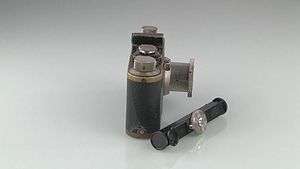
The name Leica is a combination of the first three letters of Ernst Leitz's surname and the first two from the word camera; lei-ca. The first 35mm film Leica prototypes were built by Oskar Barnack at Ernst Leitz Optische Werke, Wetzlar, in 1913. Intended as a compact camera for landscape photography, particularly during mountain trips, the Leica was the first practical 35 mm camera that used standard cinema 35 mm film. The Leica transports the film horizontally, extending the frame size to 24×36mm with a 2:3 aspect ratio, instead of the 18×24 mm of cinema cameras which transport the film vertically.
The Leica went through several iterations, and in 1923 Barnack convinced his boss, Ernst Leitz II, to make a pre-production series of 31 cameras for the factory and outside photographers to test. Though the prototypes received a mixed reception, Ernst Leitz decided in 1924 to produce the camera. It was an immediate success when introduced at the 1925 Leipzig Spring Fair as the Leica I (for Leitz camera). The focal plane shutter has a range from 1/20 to 1/500 second, in addition to a Z for Zeit (time) position.
Barnack conceived the Leica as a small camera that produced a small negative. To make big photos by enlargement, (the "small negative, large picture" concept) requires that the camera have high quality lenses that could create sharp negatives. Barnack tried a Zeiss Tessar on his early prototype camera, but because the Tessar was designed for the 18×24 mm cine format, it inadequately covered the Leica's 24×36mm negative. Barnack resorted to a Leitz Summar lens for the prototype, but to achieve resolution necessary for satisfactory enlargement, the 24x36 mm format needed a lens designed specially for it. The first Leica lens was a 50 mm f/3.5 design based on the Cooke triplet of 1893, adapted by Max Berek at Leitz. The lens has five elements in three groups—the third group being three cemented elements—and was initially called the Leitz Anastigmat. Unlike other triplets, the Leitz Anastigmat has the diaphragm between the first and second elements. When the Leica launched, this lens was renamed the ELMAX, for E Leitz and MAX Berek. By 1925, the Leitz laboratories had produced glasses with improved optical properties, and Professor Berek designed an improved version of the ELMAX called the ELMAR that had four elements in three groups. The third group was simplified to two cemented elements, which was easier and cheaper to make.[3] Professor Berek had two dogs, Hektor and Rex. The first of these, Hektor, gave his name to a series of Leica lenses, and the name of the second appeared in the SummaREX.[4]
In 1930 came the Leica I Schraubgewinde with an exchangeable lens system based on a 39mm diameter screw thread, often referred to as " Leica Thread Mount" or LTM. In addition to the 50 mm normal lens, a 35 mm wide angle and a 135 mm telephoto lens were initially available. In the mid-1930s, a legendary soft-focus lens, the Thambar 90 mm f/2.2 was designed, and made in small numbers between 1935 and 1949, no more than 3000 units. It is a rare collector's item today.[5][6]
The Leica II came in 1932, with a built in rangefinder coupled to the lens focusing mechanism. This model has a separate viewfinder (showing a reduced image) and rangefinder. In 1932 the flange to filmplane was standarised to 28.8mm, first implemented on Leica model C, and the Leica Standard the following year.[7]
The Leica III added slow shutter speeds down to 1 second, and the model IIIa added the 1/1000 second shutter speed. The IIIa is the last model made before Barnack’s death, and therefore the last model for which he was wholly responsible. Leitz continued to refine the original design through to 1957. The final version, the IIIg, includes a large viewfinder with several framelines. These models all have a functional combination of circular dials and square windows.
Early Leica cameras bear the initials D.R.P., which stands for Deutsches Reichspatent, the name for German patents before May 1945. This is probably a reference to German patent No. 384071 "Rollfilmkamera" granted to Ernst Leitz, Optische Werke in Wetzlar, on 3 November 1923.
-
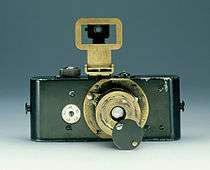
Ur-Leica ("original Leica"), from 1914
-

Leica I, 1927
-
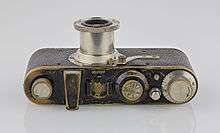
Leica I, from 1927, with collapsible Leitz Elmar 1:3,5 F=5 cm lens
-
Reproduction of the Leica Prototype, 1913, 1:3,5
The company had always had progressive labor policies which encouraged the retention of skilled workers, many of whom were Jewish. Ernst Leitz II, who took over the company in 1920, responded to the election of Hitler in 1933 by helping Jews to leave Germany, by "assigning" hundreds (even if they were not actually employees) to overseas sales offices where they were helped to find jobs. The effort intensified after Kristallnacht in 1938, until the borders were closed in September 1939. The extent of what came to be called the "Leica Freedom Train" only became public after his death well after the war.
After WWII
After the war, Leitz continued to produce the late versions of the Leica II and the Leica III through the 1950s. However, in 1954, Leitz unveiled the Leica M3 introducing the new Leica M mount, a bayonet type lens mount. The new camera also combined the rangefinder and viewfinder into one large, bright viewfinder with a brighter double image in the center. This system also introduced a system of parallax compensation and a new rubberized, reliable, focal-plane shutter. Leica continues to refine this model (the latest versions being the MP and MA, both of which have frames for 28, 35, 50, 75, 90, and 135 mm lenses, which show automatically upon mounting).
Post-war models bear the initials DBP, standing for Deutsches Bundespatent (Federal German Patent), instead of the DRP found on pre-war models. A number of camera companies built models based on the Leica rangefinder design. These include the Leotax, Nicca and early Canon models in Japan, the Kardon in USA, the Reid in England and the FED and Zorki in the USSR.
-

Leica IIIf (1950), one of the last screw-mount Leicas, with 50mm/f1.5 Summarit
-
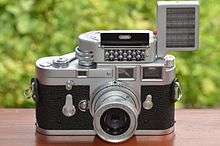
Leica M3 chrome Singlestroke (1958) with Leica-Meter M, Booster and collapsible Elmar f=5 cm 1:2,8 M39 lens with adapter
-

Leica’s MP of 2003 and M3 of 1954
-

Modern Leica M series
Factory upgrade
Until at least the mid-1950s, Leitz offered factory upgrades of earlier Leica cameras to bring them to the current model's specifications. The upgraded cameras retained their original serial number.[8][9]
Single-lens reflex cameras
From 1964, Leica produced a series of single-lens reflex cameras, beginning with the Leicaflex, followed by the Leicaflex SL, the Leicaflex SL2, and then the R series from R3 to R7, made in collaboration with the Minolta Corporation. The Leica R8 was entirely designed and manufactured by Leica. The final model was the Leica R9, which could be fitted with the Digital Module back. Leica was slow to produce an auto-exposure model, and never made a Leica R model that supported auto-focusing. Leica's U.S. official website announced (25 March 2009) that the R-series has been discontinued. The reason given was that "new camera developments have significantly affected the sales of Leica R cameras and lenses resulting in a dramatic decrease in the number sold. Sadly, therefore, there is no longer an economic basis on which to keep the Leica R-System in the Leica production programme."[10]
Conceptually bridging the Rangefinder Leicas and the SLR Leicas was the Leica Visoflex System, a mirror reflex box that attached to the lens mount of Leica rangefinders (separate versions were made for the screwmount and M series bodies) and accepted lenses made especially for the Visoflex System. Rather than using the camera’s rangefinder, focusing was accomplished via a groundglass screen. A coupling released both mirror and shutter to make the exposure. Camera rangefinders are inherently limited in their ability to accurately focus long focal-length lenses and the mirror reflex box permitted much longer length lenses. Throughout its history, Leitz has been responsible for numerous optical innovations, such as aspherical production lenses, multicoated lenses, and rare earth lenses.
The earliest Leica reflex housing was the PLOOT (Leitz's five letter code for its products), announced in 1935, along with the 200 mm f/4.5 Telyt Lens. This date is significant because that it places Leica among the 35 mm SLR pioneers. Moreover, until the 1964 introduction of the Leicaflex, the PLOOT and Visoflex were Leica’s only SLR offerings. A redesigned PLOOT was introduced by Leica in 1951 as the Visoflex I. This was followed by a much more compact Visoflex II in 1960 (which was the only Visoflex version available in both LTM [screwmount] and M-bayonet) and the Visoflex III with instant-return mirror in 1964. Leica lenses for the Visoflex system included focal lengths of 65, 180 (rare), 200, 280, 400, 560, and 800mm. In addition, the optical groups of many rangefinder lenses could be removed, and attached to the Visoflex via a system of adapters. The Visoflex system was discontinued in 1984.
Leica offered a wide range of accessories. For instance, LTM (screwmount) lenses were easily usable on M cameras via an adapter. Similarly Visoflex lenses could be used on the Leicaflex and R cameras with an adapter. Furthermore, certain LTM and M rangefinder lenses featured removable optical groups that could mount via adapters on the Visoflex system, thus making them usable as rangefinder or SLR lenses for Visoflex-equipped Screwmount and M rangefinder cameras, as well as being usable on Leicaflex and R cameras. Leica also offered focusing systems, such as the Focorapid and Televit, that could replace certain lenses’ helicoid mounts for sports and natural-life telephotography.
-

The Leica R4 (1980) and Leica SL2 MOT (1974).
-

The Leica Visoflex II (1960)
-

Leica’s answer to the SLR: a Leica Visoflex II on Leica IIIf
Company changes
In 1986, the Leitz company changed its name to Leica (LEItz CAmera), due to the strength of the Leica brand. At this time, Leica moved its factory from Wetzlar to the nearby town of Solms. In 1996 Leica Camera separated from the Leica Group and became a publicly held company. In 1998 the Leica group split into two independent units: Leica Microsystems and Leica Geosystems.
In May 2014 Leica Camera AG finished building a new factory at Am Leitz Park 1 in the new industrial part of Wetzlar and moved back to the city where it started.[11]
On November 26, 2013, Leica Camera AG announced the conclusion of a takeover process of the Swiss Sinar Photography AG. Both companies agreed not to disclose the details of the merger. Sinar Photography AG possesses product portfolio of large format 4" x 5" to 8" x 10" etc. cameras, lenses and shutter systems. Leica Camera AG announced the take over on their Facebook page.
The Blackstone Group purchased a 44% stake in 2011.[12]
Use
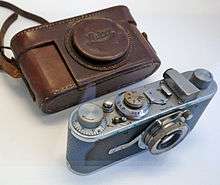
The Leica is particularly associated with street photography, especially in the mid-to-late 20th century, being used by such noted photographers as Henri Cartier-Bresson, Elliott Erwitt, Robert Frank, Bruce Gilden, Bruce Davidson, Inge Morath, Martine Franck, Sebastião Salgado, Alex Webb, Joel Meyerowitz, Garry Winogrand, Mark Cohen and Ralph Gibson.
It was also used by wartime photojournalists such as Larry Burrows.
Leica also makes a line of cine lenses used on cinematic projects.[13] In February 2015 their design team was awarded an Academy Scientific and Engineering Award for the optical and mechanical design of the Leica Summilux-C lenses.[14]
Role in antique trade
Leica cameras, lenses, accessories and sales literature are collectibles. There are dozens of Leica books and collector’s guides, notably the three-volume Leica, an Illustrated History by James L. Lager. Early or rare cameras and accessories can reach very high prices on the market. For instance, an anonymous buyer won a bidding battle for a rare 1923 Leica camera that sold for 2.6 million euros ($2.8 million) at an auction in Vienna.[15] Notably, Leica cameras sporting military markings carry very high premiums;[16] this started a market for refurbished Soviet copies with fake markings.
Leica and Panasonic
Leica-branded lenses, such as some Nocticron or Elmarit lenses, are used on many Panasonic (Matsushita) digital cameras (Lumix) and video recorders since 1995. Panasonic/Leica models were the first to incorporate optical image stabilization in their digital cameras.[17]
Leica and Valbray

In 2014, to commemorate Leica camera's 100th anniversary, they partnered with Swiss watch manufacture Valbray to develop a limited edition chronograph wristwatch with Valbray's signature Leica aperture inspired dial.[18]
List of Leica cameras


Early models
- Leica I – was first introduced to the market at the 1925 spring fair in Leipzig, based on the Ur-Leica prototype developed by Barnack in 1913 and the Prototyp 1 developed in 1923. Followed by Leica Luxur and Leica Compur (a total of 60,586 of the Leica I, Luxur and Compur models were made). Interchangeable lenses for these were introduced in 1930.
Leica 35 mm series with interchangeable lens screw mount style Leica bodies:
- Leica Standard – 1932. The first Leica camera designed with a film-to-lensflange distance of 28.8 millimeters.
- Leica II – 1932. The first Leica camera with a rangefinder.
- Leica III – 1933. Leica incorporates slow shutter speeds on this model.
C (point and shoot) series

- AF-C1 (1989)
- C2 Zoom (1991)
- Z2X (1997)
- Leica CM 40 mm
- Leica CM Zoom
Mini series
- Leica Mini (1991)
- Leica Mini II (1993)
- Leica Mini Zoom (1993)
- Leica Mini III (1995)
Minilux Series
- Leica Minilux 40 mm (1995)
- Leica Minilux Zoom (1998)
Cx Series
- C1 (2000)[19]
- C2 2002 made in China
- C3 2002
M (rangefinder) film series
The "M" within the nomenclature of this series of cameras comes from the first initial of "Meßsucher" (or "Messsucher"), which is the German word for "Rangefinder".
- M3 – 1954–66 (Total 200,000 units manufactured) Introduced at the German photokina exhibition in 1954, the M3 was the first of the M series Leicas, a line that is still manufactured today, and featured the first Leica body with a bayonet-style mount for interchangeable lenses. In an advertisement from 1956, it was regarded as a "lifetime investment in perfect photography". The M3 has a .92 magnification finder, the highest of any M camera made. The price of this high magnification was that a 35 mm lens required "goggles" that fit in front of the view/rangefinder windows to facilitate a wider view. The M3 advanced film via a lever rather than knob, the first M3s required two strokes to advance the film, after 1958 M3's were single-stroke. Early M3s lacked a frame preview selector lever to switch between framelines.
- MP – 1956–57 (Total 402 sets were manufactured). The original MP was based on the M3 and could be fitted with a Leicavit trigger winding device. MP originally stood for "M Professional"; the camera was intended as a photojournalist's camera.
- M2 – 1958–67 (88,000 sets were manufactured). A scaled-down and lower-cost version of the M3, the M2 had a simplified rangefinder of 0.72 magnification, allowing easier use of 35 mm lenses. The 0.72 magnification became the standard viewfinder magnification for future M cameras. The M2 lacked the self-resetting film frame counter of its predecessor.
- M1 – 1959–64 (9,392 sets were manufactured). A stripped-down version of the M2 for scientific/technical use, the M1 was a viewfinder camera with no built-in rangefinder. Replaced in 1965 by the MD (with no viewfinder at all), and the MDa (based on the M4) (1967), and finally the MD-2 (based on the M4-2) (1980).
- M4 – 1967–75 (50,000 sets were manufactured); 1974–75 (6,500 sets were manufactured). With added rangefinder framelines for 35 mm and 135 mm lenses. Introduced the canted rewind crank (the previous Ms had rewind knobs). With the M5, was the last M camera to have a self-timer.
- M5 – 1971–75 (31,400 sets were manufactured). With added integral TTL light meter. First Leica with a light meter, a mechanical swinging-arm CDS cell positioned behind the lens. The added functionality required a redesigned, larger body compared with the traditional M3 dimensions. Certain wide angle lenses (early 21 mm f4.0 and f3.4) could not be used in the camera without modification because of the possibility of damage to the rear element of the lens or the meter arm. For similar reasons, collapsible lenses could not be collapsed on the M5. These restrictions also held true for the Leica CL (below). With the M4, last M camera to have a self-timer.
- CL – 1973–76 (the compact Leica). Leitz Minolta CL, introduced with two lenses special to that model: the 40 mm Summicron-C f2 and 90 mm Elmar-C f4. Internal metering similar to the M5 – CDS cell on a swinging stalk. The CL is also notable for being the only M-bayonet camera to have a vertically travelling shutter. Minolta later manufactured and sold an improved electronic version, the Minolta CLE with Auto Exposure, Off-The-Film TTL metering and TTL Flash metering, together with three M-Rokkor lenses, the 40 mm/f2, 28 mm/f2.8 and 90 mm/f4.
- M4-2 – 1977–80 (17,000 sets were manufactured). First M manufactured since 1975, with stronger gears to support a motor drive. It was the first M with a hot shoe for electronic flash. No self-timer. Made in Canada.
- M4-P – 1980–86. Added rangefinder framelines for the 28 mm and 75 mm lenses.
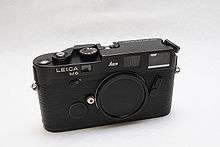
- M6 – 1984–98. A camera that first combined the M3 form factor with a modern, off-the-shutter light meter with no moving parts and LED arrows in the viewfinder. Informally referred to as the M6 "Classic" to distinguish it from the "M6 TTL" models, and to indicate its "Classic" M3 dimensions.
- M6J – 1994. A collector's edition of 1,640 cameras to celebrate the 40th anniversary of the Leica M System. Notable for its introduction of the 0.85 magnification finder, the first high-magnification finder since 1966, and the basis for the 0.85 cameras to follow starting in 1998.
- M6 0.85 – 1998. The M6 could be optionally ordered with a .85 magnification viewfinder for easier focusing with long lenses and more accurate focusing with fast lenses, such as the 50 mm/f1.0 Noctilux and 75 mm/f1.4 Summilux. The 28 mm framelines are dropped in this model. 3,130 of these cameras were made (all black chrome), so they are among the rarer non-commemorative M6's.

- M6 TTL – 1998–2002. With .72 and .85 viewfinder versions. From 2000 the .58 viewfinder camera for eyeglass wearers are added to the line. Supported TTL flash. The added electronics added 2mm of height to the top plate, and the shutter dial was reversed from previous models (traditionally, turning clockwise increased shutter speed).
- M7 2002- current model (as of 2015). Has TTL exposure, aperture priority and manual exposure, electronic shutter and two mechanical speeds of 1/60 and 1/125. Comes in .58, .72, and .85 viewfinder formats, each with different brightline framelines. Same taller top plate and counter-clockwise shutter dial as the M6 TTL. Leica even produced an M7 made of solid titanium, and offered it in a kit with 1 or several like titanium colored lenses.
- MP – 2003 – current model (as of 2015). A homage to the original MP, the new MP (this time standing for "Mechanical Perfection") cosmetically resembles the original (even down to changing the rewind crank back to a knob) but is functionally closer to the M6 Classic. A notable improvement over the M6 was the modification of the rangefinder to eliminate flare. The Leicavit M is an accessory introduced with the new MP, allowing trigger wind with the right hand at speeds up to 2–2.5 frame/s. The MP is available in chrome and black paint and with viewfinders of .58, .72 and .85 magnification.
- M-A (typ 127) – 2014 - current model (as of 2015). A purely mechanical camera with no light meter or other electronic components. It is available in silver chrome or black chrome, and has a .72 magnification viewfinder as standard.
- A La Carte Program 2004 – present. Program to facilitate custom-built combinations of metal finish, leather type, viewfinder magnification, and custom engraving.
Digital M (rangefinder) series
- M8 – 2006–09. The M8 was the first digital M introduced, featuring a 10.3 megapixel sensor. The sensor is a 1.3 crop of standard 35 mm film, which gives the M8 an enlarged perspective in comparison to its predecessors.
- M8.2 – 2008–09. A slightly updated edition of the Leica M8, featuring a quieter shutter, sapphire glass LCD screen cover, new leather coatings, etc. Because both the M8 and M8.2 sensors lack an infrared filter, an IR-cut filter in front of the lens is required to render some synthetic material colors correctly.
| Wikimedia Commons has media related to |
- M9 – 2009 – The first full frame digital camera in the series, introduced on September 9, 2009.[20]
- M9-P – 2011 – current model. The full frame digital camera with a classic look, introduced in June/July 2011.[21]
- M Monochrom – 2012 – Announced in May 2012, scheduled to ship in July 2012. A version of the M9 that shoots exclusively in monochrome. The sensor lacks both a color filtering array and an anti-aliasing filter.[22][23]
- M-E (Type 220) – 2012 – Announced in September 2012, entry-level model in the Leica M full-frame digital camera range.
- M (Type 240) – 2012 – Announced in September 2012[24][25]
- M-P (Type 240) - 2014 - Announced in August 2014, 2GB buffer and sapphire LCD cover.
- Leica M Monochrom (Type 246) - 2015 - Announced in April 2015, 2GB buffer and sapphire LCD cover.
- Leica M (Type 262) - 2015 - Announced in November 2015, No video and live view, aluminum top plate.
- Leica M-D (Type 262) - 2016 - Announced in April 2016, No back screen.
R (35 mm film SLR and DSLR) series

- Leicaflex – 1964/5 – sometimes called the Standard – built-in external light meter, clear focusing screen with centre microprism spot. There was a great deal of pressure to introduce a Leica SLR because of the phenomenal success of the Nikon F (1959).
- Leicaflex SL and SL MOT – 1968 – TTL selective-area metering, slightly taller body than its predecessor, long-lived and lovely to use. MOT model took a large and heavy motor drive. Only about 1,000 SL MOTs were made.
- Leicaflex SL2/SL2 MOT – 1974 – refinement of the SL with more sensitive light meter and improved body shape. Some thought this the toughest 35 mm SLR ever built. The Leica Solms museum has an SL2 MOT on display, with Motor and 35 mm Summicron, that survived a 25,000-foot (7,600 m) fall from a Phantom II fighter jet. It was battered but in one piece, and deemed repairable by Leica. Only about 1,000 SL2 MOTs were made. The SL2 was the last of the Leicaflexes. It reportedly cost Leitz more to manufacture than it recouped in sales, and motivated the company to collaborate with Minolta for their next series of electronic cameras. The SL2 was also the last mechanical Leica SLR for 14 years.
- Leica R3 – the first electronic Leitz SLR – 1976 to 1980, based upon the Minolta XE/Minolta XE-1/XE-7. The first few were built in Germany and then production was transferred to the Leitz Portugal factory.
- R4MOT/R4/R4S/R4S Mod2 – 1980–87 a new compact model based upon the Minolta XD-7/Minolta XD-11. The R4 set the design for all cameras up to and including the R7. The R4 offered Program mode, Aperture and Shutter Priority, and Manual, with Spot and Centerweighted metering. The R4MOT differed in designation only; all R4s and up accepted motors and winders. The R4 offered The R4S and R4S Mod2 were simplified models at slightly lower prices.
- Leica R4.[26]
- Leica R5 and R-E – 1987 – revised electronics (R5 had TTL flash capability), the RE was a simplified model.
- Leica R6 – 1988–92 mechanical shutter, relied on battery power only for the built-in light meter.
- Leica R6.2 – 1992 – as R6 but with refinements, including a 1/2000th shutter speed.
- Leica R7 – 1992 – yet more advanced electronics.
- Leica R8 – 1996–2002 – complete redesign, this time in-house with production moved back to Germany. All traces of Minolta gone.
- Leica R9 – 2002-09 – refinement of the R8 with 100g less weight and a new anthracite body finish. This model and its range of lenses was discontinued in 2009.
- R8/R9 DMR Digital Module-R – 10 megapixel digital back for the R8/R9, making them the first 35 mm SLR cameras able to capture to film or digitally. This unit was discontinued in 2008.[27]
- Leica R10 – While Leica announced in July 2009 that an R10 is forthcoming, so far one has not been released, and is unlikely given previous announcements from Leica.[28]

S (medium format DSLR) series
- Leica S1
The Leica S1 Pro is a scanner camera with a very high resolution (26 megapixels) for stationary use introduced in 1996. On a 36×36 mm2 sensor 5140×5140 pixels get scanned and optically transferred to a connected computer. The object lens adapter system was exchangeable, thus object lenses of the systems Leica R, Leica M, Hasselblad, Mamiya 4, 5×6, and all mechanic object lenses from Canon (FD), Nikon, etc. can be used with the S1. The software for the S1 is a special SilverFast version, originally developed by LaserSoft Imaging for high-end scanners. Approximately 160 cameras were built and mostly sold to museums, archives and research institutes. Later on Leica introduced the S1 Highspeed with very quick scanning and the S1 Alpha with half the resolution to the market.
- Leica S2
In 2008, Leica announced[29] plans to offer an S-System DSLR with a Kodak-made custom CCD image sensor measuring 30×45 mm and containing 37 million pixels.[30] This sensor has a 26% longer diagonal and 56% larger area than a "full-frame″ 24×36 mm DSLR sensor and outputs an approximately 5000x7500 pixel image.
| Wikimedia Commons has media related to |
The Leica S2 is thus essentially a medium format camera in a "35 mm SLR"-sized body. The new "Maestro" image processor used in the S2 was developed by Fujitsu based on the Milbeaut[31] and the autofocus system (Leica's first to see production) was developed in house. The S2 series body, lenses and accessories were available in 2009.[32] A series of new Leica lenses is manufactured specifically for the S2 and Leica claims they offer unsurpassed resolution and contrast at all apertures and focusing distances, even exceeding the sensor's capabilities. Lenses offered for the S2 include Summarit-S in normal (70 mm), wideangle (35 mm), and macro (120 mm) varieties, and Tele-Elmar (180 mm) portrait-length telephotos; these are available in versions that feature integrated multi-leaf blade shutters ("Central Shutter", or CS), in addition to the focal-plane shutter in the camera body, to enable higher flash sync speeds.[28]
- Leica S (Typ 006)
Leica announced the Leica S (Typ 006) in September 2012. It replaces the Leica S2, having a new sensor board with improved noise characteristics.
- Leica S (Typ 007)
Leica announced the Leica S (Typ 007) in September 2014. It replaces the Typ 006's CCD with a new CMOS image sensor. It offers improved noise characteristics, stills at 3.5 frames/second, and 4K video.
L mount (autofocus MILC) series
- Leica T (Typ 701)
In 2014, Leica announced Leica T (Typ 701), the first camera with a body made completely of aluminum. Initially there were two available lenses for the camera, the Leica Summicron-T 23 mm f/2 ASPH and the Leica Vario-Elmar-T 18–56 mm f/3.5–5.6 ASPH. More lenses have been announced to arrive in 2015.[33]
- Leica SL (Typ 601)
The Leica SL has the same mount as the earlier released Leica T (Typ 701), leading to the mount being rebranded from T-mount to L-mount. Crop lenses intended for use with the Leica T are now designated 'TL'.[34]
Digilux (digital) series

- Digilux
- Digilux Zoom
- Digilux 4.3
- Digilux 1
- Digilux 2[35]
- Digilux 3
- R8/R9 DMR Digital Module R (DSLR)[36]
Digital compact camera series
- C-Lux series (year of introduction)
C-LUX 1 (2006)
C-LUX 2 (2007)
C-LUX 3 (2008)
- D-Lux series (year of introduction)
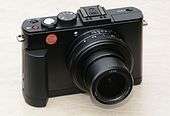
D-LUX (2003)
D-LUX 2 (2005)
D-LUX 3 (2006)
D-LUX 4 (2008)
D-LUX 5 (2010)
D-LUX 6 (2012)
D-LUX (Typ 109) (2014)
| Wikimedia Commons has media related to |
- V-Lux bridge camera series (year of introduction)
V-LUX 1 (2006)
V-LUX 20 (2010)
V-LUX 2 (2010)
V-LUX 30 (2011)
V-LUX 3 (2011)
V-LUX 40 (2012)[37]
V-LUX 4 (2012)
V-LUX (Typ 114) (2014)
- X series
Introduced with the Leica X1 on September 9, 2009. APS-C size sensor in a compact body. No viewfinder (hotshoe finder optional), fixed prime lens. In May 2012, the company introduced its successor, the Leica X2.[38] In 2013 the Leica X Vario (Typ 107) was announced: a compact body with a 16.2 MP APS-C size sensor, a fixed variable-aperture zoom (F3.5 - F6.4, 28–70 mm equivalent) and no viewfinder (plug-in electronic viewfinder optional).[39] In 2014, Leica announced two updates on the series: the Leica X-E (Typ 102) featuring a 24 mm f/2.8 lens and the Leica X (Typ 113) which has a 23mm f/1.7 lens.
- C series
On 8 September 2013 Leica announced the Leica C (Typ 112), a compact camera with an electronic viewfinder based on the Panasonic DMC-LF1.[40]
- Q series
Leica Q (Type 116) compact full frame camera with a Summilux 28 mm f/1.7 ASPH lens was officially announced in June 2015.
Sofort
.jpg)
The Sofort is an instant film camera that uses Instax Mini film or Leica's branded variant. It is set to retail at $300. It has a handful of different modes, including self-portrait, and allows adjustment of focus and brightness.[41]
List of Leica lenses
.jpg)
Leica screwmount (M39) lenses
- Elmar 50 mm f/3.5 collapsible
- Hektor 50 mm f/2.5 collapsible
- Summar 50 mm f/2 collapsible
- Summitar 50 mm f/2 collapsible
- Summarit 50 mm f/1.5 collapsible
- Summicron 50 mm f/2 collapsible (1953)
Leica M lenses
| Speed | Name | 21mm | 24mm | 28mm | 35mm | 50mm | 75mm | 90mm | 135mm |
|---|---|---|---|---|---|---|---|---|---|
| f/4.0 | |||||||||
| Super-Angulon | | ||||||||
| Macro Elmar | |||||||||
| Elmar | |||||||||
| Tele-Elmar | |||||||||
| Tri-Elmar ASPH | 16-18-21mm | ||||||||
| 28-35-50mm | |||||||||
| f/3.8 | Elmar ASPH. | ||||||||
| f/3.5 | Summaron | ||||||||
| f/3.4 | Super-Elmar ASPH. | | |||||||
| Apo-Telyt | | ||||||||
| f/2.8 | Elmar | ||||||||
| Elmarit | | ||||||||
| Elmarit ASPH. | | ||||||||
| Tele-Elmarit | |||||||||
| f/2.5 | Summarit | ||||||||
| f/2 | Summicron | | |||||||
| Summicron ASPH. | |||||||||
| APO Summicron | |||||||||
| f/1.4 | Summilux | ||||||||
| Summilux ASPH. | |
||||||||
| f/1.2 | Noctilux | ||||||||
| f/1 | Noctilux | ||||||||
| f/0.95 | Noctilux ASPH. | ||||||||
- Tri-Elmar-M 16-18-21 mm f/4 ASPH.
- Tri-Elmar-M 28–35–50 mm f/4 ASPH.
- Super-Elmar-M 18 mm f/3.8 ASPH.[42]
- Summilux-M 21 mm f/1.4 ASPH.
- Elmarit-M 21 mm f/2.8
- Elmarit-M 21 mm f/2.8 ASPH.
- Super-Angulon-M f/3.4
- Super-Angulon-M f/4.0
- Summilux-M 24 mm f/1.4 ASPH.
- Elmarit-M 24 mm f/2.8 ASPH.
- Elmar-M 24 mm f/3.8 ASPH.
- Summilux-M 28 mm f/1.4 ASPH.
- Summicron-M 28 mm f/2 ASPH.
- Elmarit-M 28 mm f/2.8
- Elmarit-M 28 mm f/2.8 ASPH.
- Summilux 35 mm f/1.4
- Summilux-M 35 mm f/1.4 ASPH.
- Summicron-M 35 mm f/2
- Summicron-M 35 mm f/2 ASPH.
- Summarit-M 35 mm f/2.5
- Noctilux-M 50 mm f/0.95 ASPH.[43]
- Noctilux-M 50 mm f/1[44]
- Noctilux-M 50 mm f/1.2[45]
- Summilux 50 mm f/1.4
- Summilux-M 50 mm f/1.4 ASPH.
- Summarit 50 mm f/1.5
- Summicron-M 50 mm f/2
- Apo-Summicron-M 50 mm f/2 ASPH.[46]
- Summarit-M 50 mm f/2.5
- Elmar-M 50 mm f/2.8
- Summilux-M 75 mm f/1.4[47]
- Apo-Summicron-M 75 mm f/2 ASPH.
- Summarit-M 75 mm f/2.5
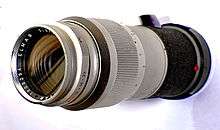
- Elmarit-M 90 mm f/2.8
- Apo-Summicron-M 90 mm f/2 ASPH.[48]
- Summarit-M 90 mm f/2.5[49]
- Macro-Elmar-M 90 mm f/4
- Elmarit-M 135 mm f/2.8
- Apo-Telyt-M 135 mm f/3.4
- Elmar 135 mm f/4.0
- Hektor 135 mm f/4.5
Note: Noctilux means f/0.95-f/1.2, Summilux means f/1.4, Summicron means f/2, Summarit means f/2.5 in the current lineup (f/1.5 in one of the 50 mm), Elmarit means f/2.8, and Elmar means f/3.5-f/4. Noct, Lux and Cron are commonly used as short forms for Noctilux, Summilux and Summicron, respectively. For example, 50 Cron uniquely identifies the Summicron-M 50 mm f/2 construction, although the exact version is not specified. Many Leica M lenses went through several revisions through the years.
Leica R lenses
- Leica 15 mm f/3.5 Super-Elmar-R – 1980 (Carl Zeiss design)
- Leica 15 mm f/2.8 Super-Elmarit-R ASPH – 2001
- Leica 16 mm f/2.8 Fisheye-Elmarit-R – 1970
- Leica 19 mm f/2.8 Elmarit-R 1st version
- Leica 19 mm f/2.8 Elmarit-R 2nd version – 1990
- Leica 21 mm f/4.0 Super-Angulon-R – 1968–92 (Schneider-Kreuznach design)
- Leica 21 mm f/3.4 Super-Angulon-R – 1968 (Schneider-Kreuznach design)
- Leica 24 mm f/2.8 Elmarit-R – 1970 (Minolta design and glass production)
- Leica 28 mm PC-Super-Angulon-R (Schneider-Kreuznach design)
- Leica 28 mm f/2.8 Elmarit-R 1st version – 1970
- Leica 28 mm f/2.8 Elmarit-R 2nd version – 1994
- Leica 35 mm f/4.0 PA-Curtagon-R (Schneider-Kreuznach design)
- Leica 35 mm f/2.8 Elmarit-R 1st version – 1964
- Leica 35 mm f/2.8 Elmarit-R 2nd version
- Leica 35 mm f/2.8 Elmarit-R 3rd version
- Leica 35 mm f/2.8 Elmarit-R 4th version (Built-in lens hood; 55mm filter)
- Leica 35 mm f/2.0 Summicron-R 1st version – 1970
- Leica 35 mm f/2.0 Summicron-R 2nd version – 1976
- Leica 35 mm f/1.4 Summilux-R
- Leica 50 mm f/2.0 Summicron-R 1st version – 1964
- Leica 50 mm f/2.0 Summicron-R 2nd version – 1977 (Built-in lens hood, 3-cam and R-cam only version)
- Leica 50 mm f/1.4 Summilux-R 1st version
- Leica 50 mm f/1.4 Summilux-R 2nd version
- Leica 50 mm f/1.4 Summilux-R 3rd version – 1997 (ROM contacts)
- Leica 60 mm Macro-Elmarit-R 1st version – 1972 – outside bayonet lens hood fitting
- Leica 60 mm Macro-Elmarit-R dn2 version
- Leica 75 mm f/2.0 Elcan-R code C-341 – Extremely rare
- Leica 80mm f/1.4 Summilux-R
- Leica 90 mm f/2.8 Elmarit-R 1st version – 1964–96
- Leica 90 mm f/2.8 Elmarit-R 2nd version – 1983
- Leica 90 mm Summicron-R 1st version – 1969
- Leica 90 mm Summicron-R 2nd version -
- Leica 90 mm APO-Summicron-R ASPH – 2002
- Leica 90 mm f/1.0 Elcan-R – Extremely rare
- Leica 100 mm f/4.0 Macro-Elmar-R bellows version
- Leica 100 mm f/4.0 Macro-Elmar-R helical version
- Leica 100 mm f/2.8 APO-Macro-Elmarit-R
- Leica 135 mm Elmarit-R 1st version – 1965
- Leica 135 mm Elmarit-R 2nd version

- Leica 180 mm Elmar-R – 1976
- Leica 180 mm f/2.8 Elmarit-R 1st version
- Leica 180 mm f/2.8 Elmarit-R 2nd version
- Leica 180 mm f/3.4 APO-Telyt-R – 1975–98
- Leica 180 mm f/2.8 APO-Elmarit-R – 1998
- Leica 180 mm f/2.0 APO-Summicron-R
- Leica 180 mm f/3.4 Elcan-R code C-303 – Extremely rare
- Leica 250 mm f/4.0 Telyt-R 1st version —
- Leica 250 mm f/4.0 Telyt-R 2nd version
- Leica 280 mm f/4.8 Telyt-V
- Leica 280 mm f/4.0 APO-Telyt-R
- Leica 280 mm f/2.8 APO-Telyt-R – 1984–97
- Leica 350 mm f/4.8 Telyt-R
- Leica 400 mm f/6.8 Telyt-R – 1968–94
- Leica 400 mm f/5.6 Telyt-R
- Leica 400 mm f/2.8 APO-Telyt-R – 1992–96
- Leica 450 mm f/5.6 Elcan-R, code C-329 – Extremely rare
- Leica 500 mm f/8 MR-Telyt-R
- Leica 560 mm f/6.8 Telyt-R – 1971–95
- Leica 560 mm f/5.6 Telyt-R – 1966–73
- Leica 800mm f/6.3 Telyt-S – 1972–95 (sold, during a promotional campaign, with a "free tripod"—a VW Fox)
- Leica modular APO-Telyt-R 260/400/560 head
- Leica modular APO-Telyt-R 400/560/800 head
- Leica 21 mm–35 mm f/3.5–f/4.0 Vario-Elmar-R zoom – 2002
- Leica 28 mm–70 mm f/3.5–4.5 Vario-Elmar-R zoom
- Leica 28 mm-90 mm ƒ2.8-4.5 Vario-Elmarit-R ASPH
- Leica 70–180 mm f/2.8 Vario-APO-Elmarit-R zoom
- Leica 35–70 f/4.0 Vario-Elmar-R zoom
- Leica 35–70 mm f/3.5 Vario-Elmar-R zoom
- Leica 35–70 mm f/2.8 Vario-Elmarit-R ASPH zoom – 2000 (only 200 was made)[50]
- Leica 70–210 mm f/4.0 Vario-Elmar-R zoom
- Leica 75–200 mm f/4.5 Vario-Elmar-R – 1976–84
- Leica 80–200 mm f/4.5 Vario-Elmar-R zoom
- Leica 80–200 mm f/4.0 Vario-Elmar-R zoom
- Leica 105–280 mm f/4.2 Vario-Elmar-R zoom
Leica S lenses
- Super-Elmar-S 1:3.5/24 mm Aspherical
- Elmarit-S 1:2.8/30 mm Aspherical
- Elmarit-S 1:2.8/30 mm Aspherical CS
- Summarit-S 1:2.5/35 mm Aspherical
- Summarit-S 1:2.5/35 mm Aspherical CS
- Elmarit-S 1:2.8/45 mm Aspherical
- Elmarit-S 1:2.8/45 mm Aspherical CS
- Summarit-S 1:2.5/70 mm Aspherical
- Summarit-S 1:2.5/70 mm Aspherical CS
- Summicron-S 1:2/100 mm Aspherical
- Apo-Macro-Summarit-S 1:2.5/120 mm
- Apo-Macro-Summarit-S 1:2.5/120 mm CS
- TS-APO-Elmar-S 1:5.6/120 mm Aspherical
- Apo-Elmar-S 1:3.5/180 mm Aspherical
- Apo-Elmar-S 1:3.5/180 mm Aspherical CS
- Vario-Elmar-S 1:3.5-5.6/30–90 mm Aspherical
Leica Summilux-C Lenses (PL mount cinema lenses)
- 16 mm T/1.4
- 18 mm T/1.4
- 21 mm T/1.4
- 25 mm T/1.4
- 29 mm T/1.4
- 35 mm T/1.4
- 40 mm T/1.4
- 50 mm T/1.4
- 65 mm T/1.4
- 75 mm T/1.4
- 100 mm T/1.4
Leica Summicron-C Lenses (PL mount cinema lenses)
- 18 mm T/2.0
- 21 mm T/2.0
- 25 mm T/2.0
- 29 mm T/2.0
- 35 mm T/2.0
- 40 mm T/2.0
- 50 mm T/2.0
- 75 mm T/2.0
- 100 mm T/2.0
- 135 mm T/2.0
Leica / Leitz enlargers
- Leitz Valoy and Valoy II – manual focus, later versions of the Valoy II were grey in colour. Valoy II normally equipped with Focotar 50 mm f1:4.5 code name DOOCQ, and used with extension ring DOORX.
- Leitz Focomat Ia – Same as Focomat 1C, that is with autofocus, but the head does not tilt back to allow for easy insertion of negative.
- Leitz Focomat Ib
- Leitz Focomat Ic – sometimes fitted with Kienzle colour head. Produced with Focotar 50 mm f1:4.5 and 2nd version Focotar-2 50 mm f1:4.5. Changes in Focotar name or focal length designation do not necessarily coincide with the optical formula. The Focotar-2 was always the same formula. The 50 mm exists in two versions. The 1c helical accommodates lenses of various makes. Available in "Color" version with filter drawer and lighted enlargement factor scale. Many small design variations exist.
- Leitz Focomat IIa – 35 mm–6×9 format, dual lens turret on later versions that fitted a 5 cm Elmar f1:3.5 or Focotar 1:4.5, and a 9.5 cm f1:4.5 Focotar, autofocus. The early version has a single helical that accommodates lenses of any make. Available in "Color" version with filter drawer and lighted enlargement factor scale.
- Leitz Focomat IIc – 35 mm–6×9 formats, dual lens stage rather than turret, autofocus. First produced with Focotar 6 cm f1:4.5 and Focotar 9.5 cm f1:4.5, later with Focotar 60 mm and V-Elmar 100 mm f1:4.5, still later with Focotar 60 mm and Focotar II 100 mm f1:5.6. 6 cm and 60 mm Focotars appear to be the same optical design. Kienzle or other colour heads sometime fitted. Only very slender enlarging lenses fit the IIc helicals. Available in "color" version with filter drawer and lighted enlargement factor scale.
- Leitz Focomat II (modified for American military), code EN-121A – Extremely rare
- Vincent electrical shutter (for enlarger) – Extremely rare
- ELCAN 52mm enlarger lens (20×–25× enlargements) – Extremely rare
- ELCAN 20mm enlarger lens (40×–75× enlargements) – Extremely rare
- Leitz/Leica Focomat V35 – mechanical autofocus – 40 mm f/2.8 Focotar lens – colour or Multigrade (variable contrast) heads. 1978–95. With the 40 mm lens – wider than normal – the V35 could make 16x20 prints (16x) directly on the baseboard, and larger prints if the baseboard was reversed for floor projection.
Financials
Leica was traded as LCA1 on the Frankfurt stock exchange until October 2012.
See also
References
- 1 2
- ↑ Duden Aussprachewörterbuch (6 ed.). Mannheim: Bibliographisches Institut & F.A. Brockhaus AG. 2006.
- ↑ Die Leica. 1933 No. 6. "Was ist eigentlich "Elmar"?
- ↑ Leica - The First Sixty Years. Gianni Rogliatti. Hove Collectors Books, 1985. ISBN No. 1-874707-02-2
- ↑ The Leitz Thambar 90 mm f/2.2 Why Is It Considered A Legendary Portrait Lens? By Roger W. Hicks, Shutterbug Posted: Apr 1, 2005
- ↑ "Technical data on the Leitz Thambar f/2.2", Thorsten Overgaard.
- ↑ Leica Collectors Guide, Dennis Delaney, Hove Collectors Books, Hove 1992, ISBN 1-874707-00-6
- ↑ Leica Screw Mount Serial #'s Sorted by Number
- ↑ "Upgrading your Leica", Thorsten Overgaard.
- ↑ Leica cease production of R9 and R lenses 03/25/2009
- ↑ ""Visiting The New Leica Campus in Wetzlar"", Thorsten Overgaard.
- ↑ Camera Maker Leica Survives the Digital Shift - WSJ
- ↑ "Leica Summilux-C and Summicron-C Cine Primes", Thorsten Overgaard.
- ↑ Leica Summilux-C Sci-Tech Oscar | Film and Digital Times
- ↑ Thompson, Robyn. "Leica camera auctioned in Austria for record $2.8 mln". Reuters. REUTERS. Retrieved 16 February 2015.
- ↑ Auction results for Luftwaffe Leica cameras
- ↑ "1995: Matsushita (Panasonic) started making all their cameras with Leica lenses", Thorsten Overgaard.
- ↑ Very Special Limited Edition EL 1 Chrono With Valbray on Quill & Pad
- ↑ camera-wiki
- ↑ "The 18 Page User Report on the Leica M9 Digital Rangefinder Camera", Thorsten Overgaard.
- ↑ Live Webcast on 9/9/2009 – The next Generation of Leica Cameras
- ↑ Grunin, Lori (May 10, 2012). "New Leica shoots the world in black and white". CNET. Retrieved May 10, 2012.
- ↑ ""Henri" User Report on the Leica M Monochrom Digital Rangefinder Camera", Thorsten Overgaard.
- ↑ "Leica M – M as in milestone". Leica Camera. September 2012. Archived from the original on September 18, 2012. Retrieved 18 September 2012.
- ↑ ""The M Experience" User Report on the Leica M Typ 240 Digital Rangefinder Camera", Thorsten Overgaard.
- ↑ Leica4
- ↑ "Leica DMR digital back for the Leica R8/R9 film cameras", Thorsten Overgaard.
- 1 2 Leica S2 Review Mark Goldstein, PhotographyBLOG updated September 25, 2008
- ↑ Leica S system specifications: Digital Photography Review Published Aug 16, 2009
- ↑ Leica S2 with 56% larger sensor than full frame DPReview, published Sep 23, 2008
- ↑ Fujitsu Microelectronics-Leica's Image Processing System Solution For High-End DSLR
- ↑ Leica reveal S-system pricing and launch date: Digital Photography Review
- ↑ Lenses for Leica T // Leica T // Photography - Leica Camera AG
- ↑ Published Oct 29, 2015 in dpreview.com
- ↑ "Leica Digilux 2 for professional photojournalistic use", Thorsten Overgaard.
- ↑ Leica Digital Modul R for the R8 & R9 Published Jun 25, 2003 | dpreview staff archive
- ↑ "The Leica V-Lux 40 Digital Camera: Classic Journeys Deserve a Classic Name in Photography". PhotographyTalk. Retrieved September 5, 2012.
- ↑ "The Leica X2 Digital Camera: For the Pure Joy of the Essential Photography Experience". Photographytalk. Retrieved September 5, 2012.
- ↑ "Leica X Vario". Digital Photography Review. Retrieved 2013-06-19.
- ↑ "Leica C (Typ 112)". Digital Photography Review. 8 September 2012. Retrieved 11 September 2013.
- ↑ Brian Heater, TechCrunch. “Leica's new instant camera has a selfie mode.” Sept. 15, 2016. Sept. 16, 2016.
- ↑ "Super-Elmar-M 18 mm f/3.8 ASPH. // M-Lenses // Leica M // Photography", Leica Camera AG.
- ↑ "Leica 50mm Noctilux-M ASPH f/0.95 "King of the Night" Model 11602", Thorsten Overgaard.
- ↑ "Leica Noctilux f/1.0 Model 11821 and 11822 Year 1976-2008", Thorsten Overgaard.
- ↑ "Leica Noctilux f/1.2 Model 11820 Year 1966-1975", Thorsten Overgaard.
- ↑ "Leica 50mm APO-Summicron-M ASPH f/2.0 and interview with lens designer Peter Karbe", Thorsten Overgaard.
- ↑ "Leica 75mm Summilux-M f/1.4", Thorsten Overgaard.
- ↑ "Leica 90 mm lenses", Thorsten Overgaard.
- ↑ "The Summarit", Thorsten Overgaard.
- ↑ "Leica 35-70 mm Vario-Elmarit-R f/2.8 ASPH - MACRO", Thorsten Overgaard.
External links
| Wikimedia Commons has media related to Leica. |
- Official website
- La Vida Leica: Leica information, reviews and articles
- Thorsten Overgaard: Leica History
- DW TV: Leica - Revival of a legend | Made in Germany
_03.jpg)
_01.jpg)
_02.jpg)
